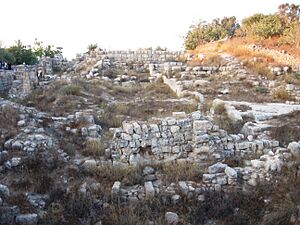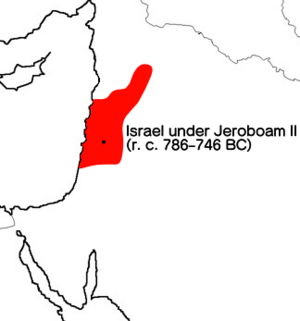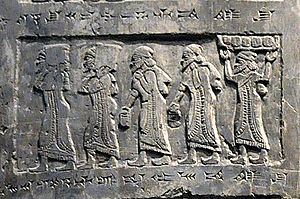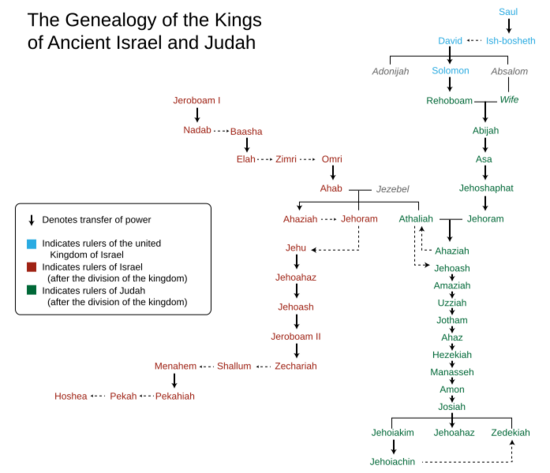Kingdom of Israel (Samaria) facts for kids
Quick facts for kids
Kingdom of Israel
𐤉𐤔𐤓𐤀𐤋
|
|||||||
|---|---|---|---|---|---|---|---|
| c. 930 BCE–c. 720 BCE | |||||||
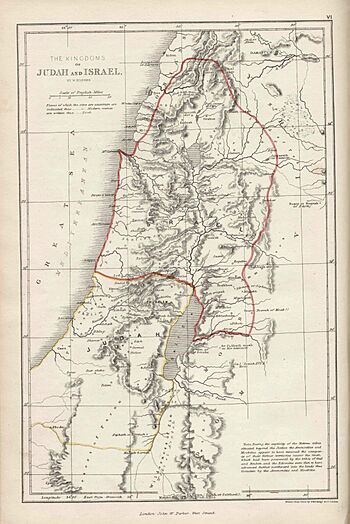 |
|||||||
| Status | Kingdom | ||||||
| Capital |
|
||||||
| Common languages | Biblical Hebrew, Israelian Hebrew | ||||||
| Religion |
|
||||||
| Government | Monarchy | ||||||
| King | |||||||
|
• 931-910 BCE
|
Jeroboam I (first) | ||||||
|
• 732–c. 720 BCE
|
Hoshea (last) | ||||||
| Historical era | Iron Age | ||||||
|
• Established
|
c. 930 BCE | ||||||
|
• Assyrian exile
|
c. 720 BCE | ||||||
|
|||||||
| Today part of | |||||||
The Kingdom of Israel (Biblical Hebrew: מַמְלֶכֶת יִשְׂרָאֵל, romanized: Mamleḵeṯ Yīśrāʾēl), also known as the Kingdom of Samaria, was an ancient kingdom in the Southern Levant during the Iron Age. It began around 930 BCE. This kingdom controlled areas like Samaria, Galilee, and parts of Transjordan.
Many towns and villages grew in Samaria and Galilee during the 900s BCE. The kingdom's first capital was Shechem, then later Tirzah. In the 800s BCE, the Omride dynasty ruled the kingdom from its new capital, the city of Samaria.
According to the Hebrew Bible, the Kingdom of Israel was one of two states that formed after the United Kingdom of Israel split. That larger kingdom was once ruled by King David and his son Solomon. The other new state was the Kingdom of Judah to the south. However, many historians and archaeologists do not believe a united kingdom as described in the Bible truly existed.
The Neo-Assyrian Empire conquered the Kingdom of Israel around 720 BCE. Records from Sargon II of Assyria show that he moved 27,290 Israelites to Mesopotamia. This was about one-fifth of the kingdom's population. This event led to the idea of the Ten Lost Tribes of Israel. Some Israelites moved to the southern Kingdom of Judah. Those who stayed in Samaria, especially around Mount Gerizim, later became known as Samaritans. The Assyrians also settled new groups of people in the conquered lands.
Contents
History of the Kingdom of Israel
Historian Israel Finkelstein suggests that the campaign of Shoshenq I in the late 900s BCE helped the Northern Kingdom to begin. Its first capital was Shechem, around 931 BCE. Israel became a stronger kingdom in the early 800s BCE. Its capital moved from Tirzah to Samaria around 880 BCE.
Ancient writings from the 800s BCE confirm that this Israelite state existed. The earliest mention is from the Kurkh stela (a stone monument) from about 853 BCE. It talks about "Ahab the Israelite" and his large army. This kingdom included parts of the lowlands, the Jezreel plain, lower Galilee, and parts of the Transjordan region.
Ahab's forces were part of a group of kingdoms fighting against Assyria. This shows that the Kingdom of Israel had powerful leaders, a royal religion with large temples, and people who could write and manage the government. It was similar to other new kingdoms of that time, like Ammon and Moab. The city of Samaria is one of the most accepted archaeological sites from this period. Around 840 BCE, the Mesha Stele (another stone monument) recorded that Moab defeated Israel.
Archaeological discoveries, ancient texts, and the Bible all show that during the time of the Omrides, Israel ruled over the mountainous Galilee region. It also controlled Hazor in the upper Jordan Valley, large parts of Transjordan, and the coastal Sharon plain.
Israel in Assyrian Records
In Assyrian writings, the Kingdom of Israel was often called the "House of Omri". The Black Obelisk of Shalmaneser III mentions Jehu, who was also called "son of Omri." The Assyrian emperor Adad-nirari III led an expedition into the Levant around 803 BCE. A stone slab from Nimrud mentions his journey to "the Hatti and Amurru lands, Tyre, Sidon, the land of Omri, Edom, Philistia and Aram."
Another text from the same king, the Rimah Stele, refers to the kingdom as Samaria. It mentions "Joash of Samaria." Even later, Sargon II used the phrase "the whole house of Omri" when he conquered Samaria in 722 BCE. It is interesting that the Assyrians did not mention the Kingdom of Judah until the late 700s BCE. This might mean they had no contact with Judah, or they saw it as part of Israel or Aram, or perhaps the southern kingdom was not yet important.
The Kingdom in the Bible
The Hebrew Bible, especially the Books of Kings and Chronicles, is a traditional source for the history of the Kingdom of Israel. These books were written by authors in Jerusalem, the capital of the rival Kingdom of Judah. Their writings were influenced by their own beliefs and viewpoints. Some events described might have happened long after the Kingdom of Israel was destroyed.
Biblical archaeology has both supported and questioned parts of the biblical story. According to the Hebrew Bible, there was once a United Monarchy ruled from Jerusalem by David and his son Solomon. After Solomon's death, Israel and Judah split into two separate kingdoms.
The name Israel first appears in an Egyptian writing called the Merneptah Stele, from about 1208 BCE. This shows that the name was used before the kingdom itself was formed.
Relations with Judah
The Hebrew Bible says that for the first 60 years after the split, the kings of Judah tried to regain control over the northern kingdom. There was constant war between them. For the next 80 years, there was no open war. Judah often made military alliances with Aram-Damascus, which created a northern front against Israel.
The conflict between Israel and Judah ended for a while when Jehoshaphat, King of Judah, formed an alliance with Israel's ruling family, the family of Ahab. This was done through marriage. Later, Jehosophat's son, Jehoram of Judah, married Ahab's daughter Athaliah, making the alliance stronger. However, Jehu later killed Ahab's sons during his coup d'état around 840 BCE.
From Hazael to Jeroboam II
After being defeated by Hazael, Israel slowly began to recover. This happened after campaigns against Aram-Damascus by Adad-nirari III. This recovery led to a time of great growth under Jeroboam II. He expanded the kingdom's lands across the Northern Transjordan. After Jeroboam II died, the kingdom began to decline. This was due to rivalries and struggles for the throne.
The End of the Kingdom (732–720 BCE)
Around 732 BCE, King Pekah of Israel joined forces with Rezin, king of Aram. They threatened Jerusalem. Ahaz, the king of Judah, asked Tiglath-Pileser III, the king of Assyria, for help. After Ahaz paid tribute to Tiglath-Pileser, the Assyrian king attacked Damascus and Israel. He took control of Aram and the lands of the tribes of Reuben, Gad, and Manasseh in Gilead.
People from these tribes were taken captive and moved to the Khabur River area in Mesopotamia (1 Chronicles 5:26). Tiglath-Pileser also captured the land of Naphtali and the city of Janoah in Ephraim. An Assyrian governor was put in charge of the Naphtali region. According to 2 Kings 16:9 and 2 Kings 15:29, the people of Aram and the captured part of Israel were sent to Assyria.
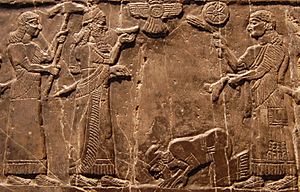
The rest of the northern Kingdom of Israel continued to exist in a smaller area until about 720 BCE. Then, Assyria invaded again, and the remaining people were deported. During a three-year siege of Samaria by the Assyrians, Shalmaneser V died. Sargon II became king and recorded capturing the city. He said: "Samaria I looked at, I captured; 27,280 men who dwelt in it I carried away" into Assyria.
So, around 720 BCE, after about 200 years, the kingdom of the ten tribes ended. Some Israelite captives were moved to the Khabur region, and others to the land of the Medes. This created Hebrew communities in Ecbatana and Rages. The Book of Tobit also says that Sargon took other captives from the northern kingdom to the Assyrian capital of Nineveh.
The Hebrew Bible says that the people of the Kingdom of Israel were exiled and became known as the Ten Lost Tribes. To the south, the Tribe of Judah, the Tribe of Simeon, the Tribe of Benjamin, and the Tribe of Levi remained in the southern Kingdom of Judah. The Kingdom of Judah continued to exist until 586 BCE, when the Neo-Babylonian Empire conquered it.
The Samaritan Version
Samaritan tradition says that many people from the Kingdom of Israel stayed in their homes after the Assyrian captivity. This included people from the Tribes of Naphtali, Manasseh, Benjamin, and Levi. These people are believed to be the ancestors of today's Samaritans.
In their book The Bible Unearthed, authors Israel Finkelstein and Neil Asher Silberman estimate that only about one-fifth (around 40,000) of the Kingdom of Israel's population was actually moved out of the area. This happened during the two deportation periods under Tiglath-Pileser III and Sargon II. Many people from these northern tribes also fled south to the Kingdom of Judah. Jerusalem seems to have grown five times larger during this time. King Hezekiah had a new wall built and a new water source (Siloam) provided for the city.
Recorded History of Deportations
In their book The Bible Unearthed, Israel Finkelstein and Neil Asher Silberman estimate that only about 40,000 people from the northern Kingdom of Israel were actually moved out of the area. This happened during the two deportation periods under Tiglath-Pileser III and Sargon II.
No non-Biblical records mention the Assyrians exiling people from four of the tribes of Israel: Dan, Asher, Issachar, and Zebulun. Descriptions of the deportations from Reuben, Gad, Manasseh, Ephraim, and Naphtali show that only a part of these tribes were moved. The places where they were sent are known locations mentioned in the accounts.
The deported communities are mentioned as still existing when the Books of Kings and Chronicles were written. They did not disappear by mixing with other groups. 2 Chronicles 30:1–18 specifically mentions northern Israelites who were not taken by the Assyrians. These included people from Ephraim, Manasseh, Asher, Issachar, and Zebulun. It also describes how members of the last three tribes returned to worship at the Temple in Jerusalem during the rule of Hezekiah.
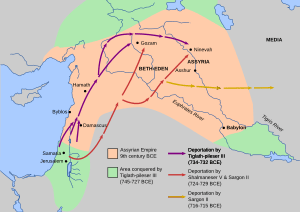
Religion in the Kingdom
The religious practices in the Kingdom of Israel seem to have followed two main paths. The first was the worship of Yahweh, often called Yahwism by modern scholars. However, the Hebrew Bible also states that some northern Israelites worshipped Baal (see 1 Kings 16:31). The reference in Hosea 10 to Israel's "divided heart" might mean they were unsure between these two religions. It could also mean they were unsure whether to seek help from Assyria or Egypt.
The Jewish Bible also says that Ahab allowed the worship of Baal to become accepted in the kingdom. His wife Jezebel was the daughter of the Phoenician king of Tyre and was a strong follower of Baal worship (1 Kings 16:31).
Royal Families
According to the Bible, the Northern Kingdom had 19 kings from 9 different ruling families. This was over its 208 years of existence.
Images for kids
See also
 In Spanish: Reino de Israel para niños
In Spanish: Reino de Israel para niños


